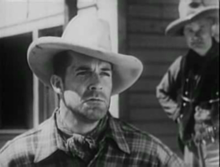
Rex Lloyd Lease was an American actor. He appeared in over 300 films, mainly in Poverty Row Westerns.

Ernest Torrence was a Scottish film character actor who appeared in many Hollywood films, including Broken Chains (1922) with Colleen Moore, Mantrap (1926) with Clara Bow and Fighting Caravans (1931) with Gary Cooper and Lili Damita. A towering figure, Torrence frequently played cold-eyed and imposing villains.
Ruth F. Riese of Saginaw, Michigan, was an American amateur tennis player in the 1920s.

Norman Kerry was an American actor whose career in the motion picture industry spanned twenty-five years, beginning in 1916 and peaking during the silent era of the 1920s. Changing his name from the unmistakably German "Kaiser" at the onset of World War I, he rose quickly in his field, becoming "the Clark Gable of the [1920s]."

Reginald Harry Barlow was an American stage and screen character actor, author, and film director. He was a busy performer in Hollywood films of the 1930s.
Jack Hill was an American film actor and stuntman, who appeared in scores of Laurel & Hardy comedies.

Albert S. Rogell was an American film director who was born in Oklahoma City and died in Los Angeles. Rogell directed more than a hundred movies between 1921 and 1958. He was known for an aggressive directing style, shouting at his actors and crew.

Lafayette S. "Lafe" McKee was an American actor who appeared in more than 400 films from 1912 to 1948.

Harry Lewis Woods was an American film actor.

Walter Harry "Monte" Montague was an American film actor and stuntman. He appeared in more than 190 films between 1920 and 1954.
Ralph Carl Ceder was an American film director and writer. He directed 88 films in the 1920s, 1930s, and 1940s.

William V. Mong was an American film actor, screenwriter and director. He appeared in almost 200 films between 1910 and 1939. His directing (1911–1918) and screenwriting (1911–1922) were mostly for short films.

James Lew Meehan was an American film actor.

Charles Orbie "Slim" Whitaker was an American film actor. He appeared in more than 340 films between 1914 and 1949. He was born in Kansas City, Missouri, and died in Los Angeles, California, from a heart attack.
Jack Natteford was an American screenwriter. He wrote for more than 140 films between 1921 and 1967. He was born in Wahoo, Nebraska and died in Los Angeles County, California. He was married to fellow screenwriter Luci Ward.

William R. Walling was an American actor of stage and film in the silent era.
Bud Geary, was an American film actor. He appeared in 258 films between years 1920 and 1946.

James Horatio Bradbury Jr. was an American character actor in supporting roles on stage and in films of the 1920s and 1930s.

Ruth Mildred Dwyer was an American film actress. She had a number of starring roles in the silent era, most famously as Buster Keaton's leading lady in Seven Chances (1925). Dwyer mostly retired in 1928 and played a number of uncredited roles in sound films, but retired from the film business completely in the 1940s.
Harold Dunham Speakman was an early twentieth-century American author and artist, best known for the travel narratives Here’s Ireland (1925) and Mostly Mississippi (1927).
















